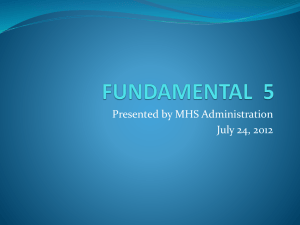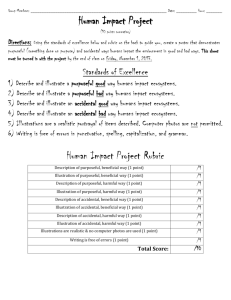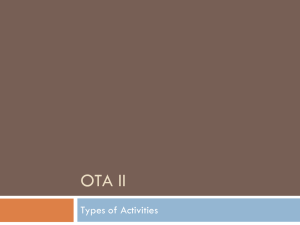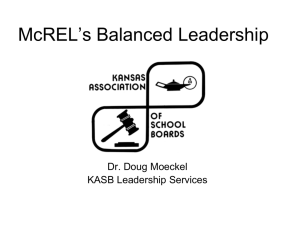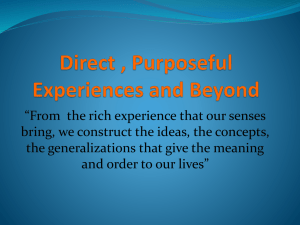File - worldofoccupational therapy
advertisement
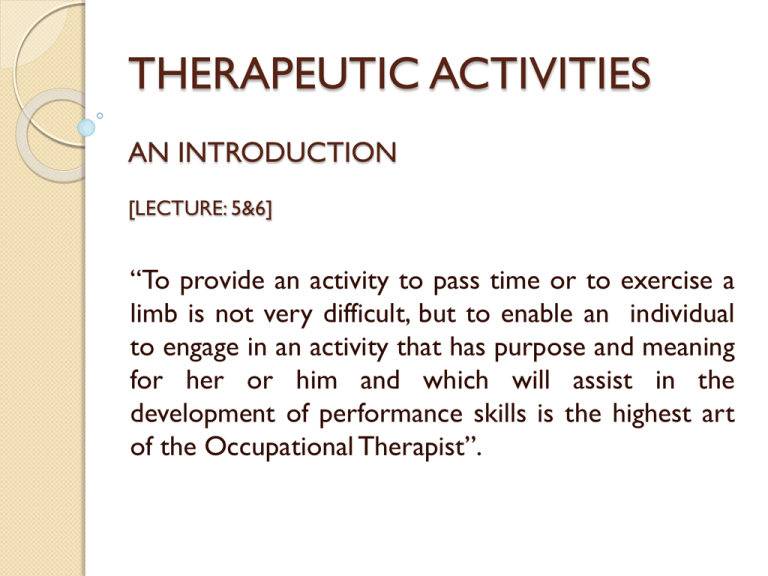
THERAPEUTIC ACTIVITIES AN INTRODUCTION [LECTURE: 5&6] “To provide an activity to pass time or to exercise a limb is not very difficult, but to enable an individual to engage in an activity that has purpose and meaning for her or him and which will assist in the development of performance skills is the highest art of the Occupational Therapist”. Therapeutic activities It involves using functional activities to improve functional performance in progressive manner. These activities can be purposeful or nonpurposeful. Intrinsic value of Therapeutic Activities Activities- both the process of doing them and their end product have value at many different levels. Values of an activity: Learning tools- develop skills Structure time Productive- meet needs of being purposeful and creative Allow expression and exploration of feelings Stimulation and activation Play, pleasure and social interaction and connection Knowledge, competence and mastery Occupation and Purposeful Activity The term Occupation and Purposeful activities used interchangeably, the commission on practice discriminated between two; it defines Occupation as active participation in self maintenance, work, leisure and play and defined Purposeful activity as goal directed behaviors or tasks that comprise occupations (AOTA, 1993) Core Concepts: Elements of Occupation Personally experienced and goal directed Reflects culture and cultural values Provides meaning Involves multiple tasks Provides organization and structure to living Meets needs of the individual and others in the social world Fills time Uses abilities and skills May have a physical and/or mental component Is recognized by the culture Provides pleasure and enjoyment Contributes to family and broader community Contributes to health and well-being Aligns with development of the individual Purposeful Activity Small units of behavior Use of objects Action May or may not produce an object Goal directed Required for development, maturation and use of sensory -perceptual, motor, social, psychological, and intellectual functions Purposeful and Non-purposeful Activity A purposeful activity is the activity has an autonomous or inherent goal beyond the motor functions required to perform the task, conversely non-purposeful activity has been defined as activity in which there is no inherent goal other than the motor function used to perform the activity. Purposeful activity has both inherent as well as therapeutic goals. Pic.1: non-purposeful activity; shoulder wheel Pic.2: Purposeful activity: Straw cutting activity Pic.1: Wall mounted Finger ladder, Pic.2: Wall painting Pic.1: Inclined Sanding Activity, Pic.2: Window Cleaning Pic1/:Wood sanding, Pic.2: Tabletop cleaning, Pic.3: Ironing, Pic.4: Horizontal sanding activity Pic.1: Static Cycle, Pic.2: Pedo Cycle Cycling: Purposeful Activity Objectives of the therapeutic activity Purposeful activities are used to or adopted to one or more of the following objectives: To develop or maintain strength, endurance, tolerance, range of motion and coordination. To practice and use voluntary, automatic movements in goal directed tasks To provide for purposeful use of general exercise to affected parts To explore vocational potential or trained in work skills To improve sensation, perception and cognition To improve socialization skills and enhance emotional growth and development Characteristics of therapeutic activities Activities selected fir the therapeutic purpose should have following characteristics: Be goal directed Have some meaning to the patient to meet individuals needs in relation to social roles Requires the mental and physical participation of the patient Be designated to prevent or reverse dysfunction Develop skills to enhance performance in life roles Relate to the patient’s interest Be adaptable, gradable and age appropriate Be selected through knowledge and professional judgment of the Occupational therapist in concert with the patient. Activity Adaptation: To adapt an activity means to modify it and it involves changing the changing the components that are required to complete the task. Adaptations are made to allow the patient to experience success in task accomplishment at his/her level of functioning. Activity Gradation: Grading an activity refers to the process of performance being viewed step by step in a continuum that progress from simple to complex.
